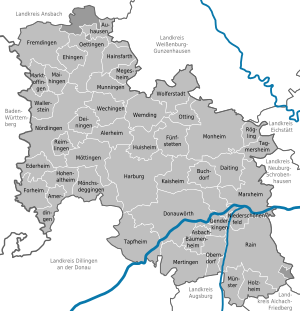Donau-Ries
You can helpexpand this article with text translated fromthe corresponding articlein German.(January 2021)Click [show] for important translation instructions.
|
Donau-Ries | |
|---|---|
 | |
| Country | Germany |
| State | Bavaria |
| Adm. region | Swabia |
| Capital | Donauwörth |
| Government | |
| • District admin. | Stefan Rößle (CSU) |
| Area | |
| • Total | 1,275 km2(492 sq mi) |
| Population (31 December 2022)[1] | |
| • Total | 137,137 |
| • Density | 110/km2(280/sq mi) |
| Time zone | UTC+01:00(CET) |
| • Summer (DST) | UTC+02:00(CEST) |
| Vehicle registration | DON, NÖ |
| Website | www |
Donau-Ries(Danube-Ries) is aLandkreis(district)inSwabia,Bavaria,Germany.It is bounded by (from the north and clockwise) the districts ofAnsbach,Weißenburg-Gunzenhausen,Eichstätt,Neuburg-Schrobenhausen,Aichach-Friedberg,AugsburgandDillingen,and by the state ofBaden-Württemberg(districts ofHeidenheimandOstalbkreis).
History[edit]
FromPalaeolithictimes on theNördlinger Rieswas a very attractive site for human settlement. The valley of the Danube was abounding with game, and many caves in the slopes of the crater provided shelter forNeanderthalsand their successors.
The Ries was always densely populated. From 450 to 15 BCCelticpeoples built their settlements on the tops of the hills. Remains of Celticcircular fortsand sanctuaries can be found all over the region. They were replaced about 90 AD by theRomans,who secured the region by building forts and theLimes(which was some km north of the present district).
The Romans were driven away about 250 AD by theAlamanni,which in turn were defeated by theFranksin 496. In the early years of theHoly Roman Empirenew castles were erected, among themSchloss Oettingen,which was the centre of the county ofOettingen.This county was first mentioned in 1141, ruled over the villages of the Ries and managed to gain further territories around. In the 15th century the county was divided into the two states ofOettingen-OettingenandOettingen-Wallerstein.Later the former decided to becomeProtestant,while the latter remainedCatholic.This was the reason for a bloody enmity resulting in decades of war. Even prior to the Thirty Years' War there were battles, mass executions andwitchhuntsin both parts. In theThirty Years' Warthe Ries was almost completely devastated and depopulated. Two major battles of that war took place in the region: theBattle of Nördlingen (1634)and theBattle of Nördlingen (1645).
After the war, the Counts of the mini-states (in the meantime a third county calledOettingen-Spielberghad been founded) recruited settlers fromAustriato repopulate the land. The hostilities between the counties were revived. There was fighting in theWar of the Spanish Succession,with two major battles taking place in the Ries. All this came to an end, when the last Protestant ruler of Oettingen-Oettingen died without a successor. The remaining states of Oettingen-Wallerstein and Oettingen-Spielberg annexed his lands and turned them into a Catholic region.
In 1806Napoleondissolved both Oettingen states and awarded them toBavaria.In theCongress of Viennathe affiliation of the region with Bavaria was confirmed, and the sovereignty of the Ries ended.
The present district was established in 1972 by merging the former districts of Nördlingen and Donauwörth.
Geography[edit]
In the south, theDanubecrosses the district, running from west to east. It is joined by theLechriver coming from the south. North of the river there is a hill chain, the so-calledRiesalbconnecting the mountain chains of theSwabian Albin the west and theFrankish Albin the east. Further north there is theNördlinger Ries,a huge depression, which is in fact an ancientimpact crater,caused by ameteoritesome 14.8 million years ago.
Politics[edit]
Donau-Ries (electoral district)
Coat of arms[edit]
The coat of arms displays:
- The eagle of theHoly Roman Empiresymbolising the Free Imperial Cities of Donauwörth and Nördlingen
- The yellow cross on red background was part of the arms of all Oettingen counties
- The blue and white checkered pattern of Bavaria
Towns and municipalities[edit]

| Towns | Municipalities | |
|---|---|---|
References[edit]
- ^Genesis Online-Datenbank des Bayerischen Landesamtes für Statistik Tabelle 12411-003r Fortschreibung des Bevölkerungsstandes: Gemeinden, Stichtag(Einwohnerzahlen auf Grundlage des Zensus 2011).
External links[edit]
- Official website(German)



